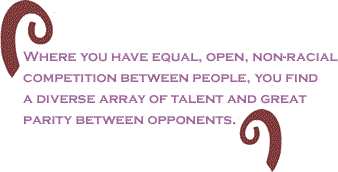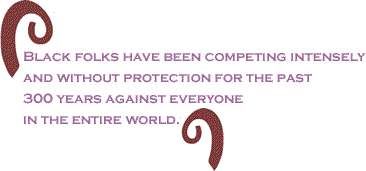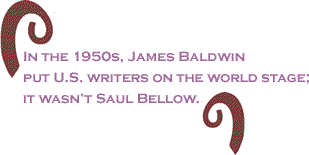
|
|||||||||||||||||||||
|
|
After Bush won re-election, many on the white left went into a self-serving identity crisis. Have we lost touch with the Christian fundamentalists? And the whole war thing, maybe it’s not such a bad idea after all, killing them before they kill us. Howard Dean says he now supports the U.S. occupation of Iraq, and all but a handful of Democrats in Congress voted for the new war budget. As far as the liberal intelligentsia goes, Time just named Ann Coulter one of the “100 Most Influential People,” and then an issue later gave her the cover (April 25). Coulter is the rabid white woman ranting blithely on all the rightwing TV talk shows about the evils of civil rights, women’s equality, environmentalism, and Arab people. She says that “Arabs lie,” “women are not too bright,” and that desegregating the public schools has led to “illiterate students knifing one another between acts of sodomy in the stairwell.” The publisher of her book Slander had to retract five of her many inventions of fact after the book was initially printed. Time speaks of her as “iconic.” The U.S. trade deficit keeps growing. It’s now about 6 percent of the GDP, more than 600 billion per year. The Japanese and the Chinese together own 44 percent of the U.S. foreign debt. The dollar, like everything else about the society, is greatly overblown and destined to shrink back to its normal size, as it continues to do every day. The U.S. middle class is the smallest among the wealthiest nations of the world. Italy and Spain have more middle class people than does the U.S. Forty percent of the U.S. population lives in poverty, and the vast majority goes from paycheck to paycheck. The average American hasn’t seen an increase in their real wages for the past twenty years and owes $12,000 in credit card debt. The number of long-term unemployed who are college graduates has tripled since 2000. According to the Los Angeles Times, one in five of the long-term jobless are college graduates.
A recent survey of U.S. high school students indicates that 80 percent cannot locate the U.S. on a world map. BC just reported that more than half of all black students in the U.S. fail to finish high school while close to 80 percent of whites are issued diplomas; it seems these are the same white students who can’t find their own country on the map. Robert Fisk has reported firsthand from Iraq that, in more than two years of fighting, the U.S. military has been unable to secure even one road outside of Baghdad. Bush is indeed the worst president in the history of the country, below even the most mediocre such as Reagan and Bush’s own father. But isn’t the real question: where did all this mediocrity come from? What’s the root of it? The way out of mediocrity, as any sports coach will tell you, is competing against someone better than you. On this note, look at how terrible is the state of white American athletics. The only good white American athletes today are in golf, tennis, soccer, hockey, and track and field where the competition is openly international. And it’s not simply a matter of money, as the Williams sisters proved incontestably. That’s a red herring. It’s about open international competition. In the major U.S. national sports that are protected from international competition such as baseball, football, and basketball – team sports in which white kids rarely compete directly any more with not-white kids when they’re learning their skills – there is a shocking dearth of new white talent. For example, the formerly “smart white” positions, such as catcher, point guard, and quarterback, have been taken over by Latinos and African Americans, mainly because of resegregation: the increased protection of whites from not-white competition. Never competing against anyone other than themselves, whites have produced a plantation sports entertainment system that is a total bore compared to the NBA, MLB, and NFL of the 1970s and 80s. In the 70s and 80s the real effects of desegregation could be felt in every game, between a fourth place Detroit Tigers team versus a third place New York Yankees squad, for instance. Lightening fast Ron Leflore leading off for the Tigers, straight from Jackson State Penitentiary, looking out at an all-African American New York Yankee outfield: Roy White, Mickey Rivers, and Oscar Gamble. And we need not reminisce about the great battles between the Bad Boys and MJ, or Kareem and Magic against Bird and McHale. Nobody will be taken seriously who tries to argue that the NBA today is worth watching for more than the last five minutes of a game, even in the playoffs.
In popular culture, it’s very different because there’s no way whites can avoid competition with blacks, and so a lot of country music is really good and always has been. As we know, Elvis stole his music from black bluesmen such as Big Boy Crudup. The hit that launched Elvis was “That’s All Right,” a Crudup original. Musicologist Arnold Shaw notes in his massive history of R & B, Honkers and Shouters, that “That’s All Right” was Elvis’ first release on Sun Records “and as close to Big Boy’s phrasing, blue notes, and high tessitura as he could make it” (p. 33). This direct competition was good for Elvis and it made him and the flock of other white artists after him, from Creedence Clearwater Revival down to Elton John and Rod Stewart (each has in common a cover of “That’s All Right”), step up their game. Of course the black artists they competed against were robbed of the riches they produced, but the issue here is how to climb out of mediocrity, not the filthy machinations of racist industry CEOs and their lawyers, which is a long story fully documented by Shaw in his great book. Contemporary white rock, whether you prefer it or not, is far from mediocre, as is white comedy. Mike Myers, Jim Carrey, and Will Ferrell are superb comedians precisely because they came up in direct competition with black comedians. In the world of hip hop music and culture, Richard Pryor, Eddie Murphy, the Wayan brothers, Chris Rock, Tiger Woods, the Williams sisters, and the Kenyan runners, any white person seeking to make it in these fields has to prove themselves against superior not-white competition. The general pattern is that where you have equal, open, non-racial competition between people, you find a diverse array of talent and great parity between opponents. No dynasties and no wretched stinkers, just healthy competition as in the NHL, the World Cup or the U.S. Open in golf and tennis. Is that why they cancelled the NHL season? They must have been setting a bad example for U.S. workers. Moreover, notice the increase in black NHL players. Contrary to popular opinion, there have been few blacks in the NHL not necessarily because of white racism but because the black communities in Canada are tiny. (The black population of Canada is around 660,000, less than 1 percent of its total population.) The same cannot be said for all-white NASCAR or professional bowling, the two most ridiculous excuses for sports entertainment on the market.
The worst mediocrity in U.S. society is labor consciousness. Despite increasing our labor productivity by 82 percent over the last decade, our wages have gone up just 9 percent. All this wealth was transferred directly to the top one percent of the population, which currently owns and controls 40 percent of it and is ready to loot $1.5 trillion from the Social Security Trust Fund. Yet there have been no great strikes and no major political confrontations in the U.S. between labor and capital. These facts need to be looked at in the context of white male protectionism, studies that are done only by African American intellectuals. The white radicals are completely lost on the question of U.S. mediocrity. Typically they confuse symptoms for the origin: for example, when they say that poor whites are morons and therefore they merely re-elected a moron like themselves. But if poor whites really are morons, what has made them this way? By fighting against desegregation and the civil rights agenda, white workers have been working hard for their own pungent mediocrity and bland homogeneity. People talk about “the politics of fear,” but the real fear is not Muslim terrorists. The real fear is an old fear, the mother of all U.S. fears: that whites will one day have to compete against equal or in many cases superior opponents, namely black folks, who have been competing intensely and without protection for the past 300 years against everyone in the entire world. Just take Tiger Woods: what nationality hasn’t he defeated already? Who will be next? Often this fact is born out best in one of the most advanced forms of individual competition, the construction of a novel. Ishmael Reed wrote once that “writing is fighting,” and he had in mind this concept of a healthy multiethnic U.S. competition among working people. In fact, it was Reed who coined the term “multiculturalism” back in the 1960s, although hardly anyone ever credits him for this advance in human thought. And more than any other U.S. writer, it has been Reed who keeps excavating the root of the U.S. mediocrity problem. For example, he says sharply in his novel Japanese by Spring (1993), through the character of Professor Chappie Puttbutt, that “No matter how high a white may rise in this society’s intellectual circles, with few exceptions they’re still monolingual and culturally restricted crackers” (p. 108). Later in the novel, Reed puts it more geopolitically, and prophetically, through the Japanese nationalist Dr. Yamato:
Perhaps the most gripping moment of Reed’s novel is when his plot forces Dr. Crabtree, a PhD in the Western classics, to either learn Yoruba or retire from the profession. Dr. Crabtree opts to keep his job. Here’s Crabtree reflecting on the experience to a room full of angry colleagues who were challenged in a similar fashion:
Reed writes what he calls “neo-hoodooo aesthetics,” and his novels are among the best that U.S. literature has to offer the world. In closing, I want to draw attention to the importance of African American imaginative writers who are frequently left out of the great public debates of our times such as this new one, termed by the economist Robert Pollin “the contours of descent,” a reference to the pathetic U.S. economy.
In the 1980s, August Wilson saved Broadway from empty theater mediocrity. In the 1970s, Toni Morrison, Gloria Naylor, and Gayl Jones staved off U.S. women’s writing from the offensive launched by reactionary feminism. They showed compellingly in their fiction that women do just as much damage to each other as men do to them, that it’s time to face this reality and change it. Read Morrison’s brilliant essay “Cinderella’s Stepsisters” for the theory. Morrison also single handedly rejuvenated the study of American literature by advancing the thesis in Playing in the Dark that the “Africanist presence” in the U.S. tradition is what brings to life otherwise insipid stories no one would ever read. In the 1960s, Amiri Baraka rescued U.S. poetry from the lifeless pentameter and stale imagism; the beatniks are impossible without his jazz aesthetic. In the 1950s, James Baldwin put U.S. writers on the world stage; it wasn’t Saul Bellow. In the 1940s, Richard Wright gave the U.S. a new name in epic literature. In the 1930s, which is where the U.S. economy today appears headed, Langston Hughes made the African American folk tradition an internationally beloved and widely emulated form of expression. When he would travel to Latin America and the Caribbean, everyday people on the street recited famous Hughes poems back to him. In Mexico, the muralists worshipped the ground he walked on. The Soviet Union invited him to make a blockbuster movie about race in the U.S. Cuba’s national poet Nicolás Guillén credited Hughes with inspiring his immersion in black Cuban music and dance culture, and a few years later Hughes translated Guillén’s best poems into English in a volume entitled Cuba Libre. In the 1920s, Dr. DuBois contradicted once and for all the myth that the U.S. could never produce a Marx or a Freud. The Souls of Black Folk remains the fulcrum of U.S. sociology and his concept of “double consciousness” is one of the greatest contributions to modern thought. Wasn’t it Walter Mosley who revived the detective novel, which was starting to lose its rebelliousness? How can you be a white man and an outsider at the same time anyway? The bringers of doom and gloom want us to believe that people have stopped reading, so why pay attention to writers any more? This could be one of the most reactionary arguments being made today. More than anything, we need to raise our writers to prominence again. For example, people have stopped buying poetry, you can’t give it away, except the dead white alcoholic Charles Bukowski. He still sells. But people used to read poetry. Look at Dudley Randall’s Broadside Press in Detroit. They once published millions of poetry books. But then Baraka and the other leading innovators were isolated and charged with “black racism” and anti-Semitism. Today Baraka is read widely all over Europe but not in the U.S. Also, we need to remind white American radicals that they wouldn’t exist today had it not been for African American writers. Do they imagine they can avoid falling into the pit of U.S. mediocrity without studying systematically the work of black intellectuals? We’ll find out soon enough, for the race to the bottom is reaching the finish line. Jonathan Scott is an Assistant Professor of English at the City University of New York, Borough of Manhattan Community College. He can be reached at [email protected]. |
Your comments are always welcome. Visit the Contact Us page to send e-Mail or Feedback or Click here to send e-Mail to [email protected] e-Mail re-print notice
If you send us an e-Mail message we may publish all or part of it, unless you tell us it is not for publication. You may also request that we withhold your name. Thank you very much for your readership. |
| May 19 2005 Issue 139 |
|||||||||
|
|||||||||
|
|
|||||||||
| Printer Friendly Version | |||||||||
 |
|||||||||
 |
|||||||||
| |
|||||||||
| |
|||||||||





























